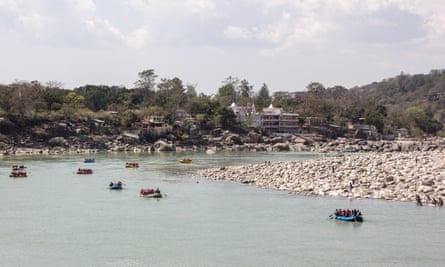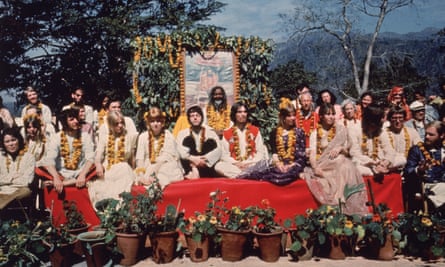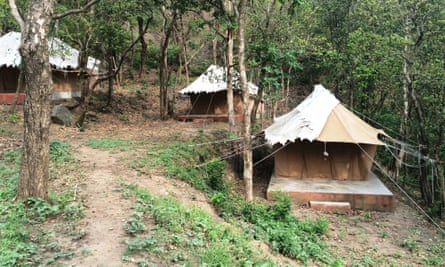I’ve only been in the raft a few minutes, bobbling down a placid stretch of India’s holy Ganges River, before my guide, Kalyan Singh Bhandari, puts his paddle down and sings a haunting Garhwali folk song typical of these Himalayan foothills. The warbling tune is, he says, meant to bring us good luck as we navigate the class 3 and 3+ rapids ahead.
The Guardian’s product and service reviews are independent and are in no way influenced by any advertiser or commercial initiative. We will earn a commission from the retailer if you buy something through an affiliate link. Learn more.
Glistening in toothpaste blue, the Ganges winds its way from its source at the Gangotri glacier, up near the Tibetan border, through the northern state of Uttarakhand to the spiritual city of Rishikesh (it finally empties into the Bay of Bengal, thousands of kilometres away). Paddling just upstream from Rishikesh along a 16km route of rapids, I watch as orange-robed sadhus (Hindu ascetics) bathe at the river’s edge. Pink-faced rhesus macaques are swinging through the evergreen trees that rise out of the steep valley.
About 30 minutes into the journey, a Class 3+ rapid named Golf Course appears on the horizon, looking like a wall of white in front of our red raft. We collide with it head on and swirl around through 180 degrees. By the time we realign the raft and paddle onward into more Class 3 rapids I’m drenched, and slapped silly by the skin-stinging river water.
Hindus believe bathing in the Ganges washes away sins, so Kalyan jokes that I should feel a lot lighter now. Electric with the adrenaline of adventure, I tell him I most certainly do.

We crash over more rapids before reaching a lazy stretch near the Osho Gangadham, an ashram set up by followers of the guru Osho, better-known in the 1980s as Bhagwan Shree Rajneesh, whose controversial community in the Oregon desert was the focus of a Netflix docuseries Wild Wild Country. A western woman in a scarlet frock sits on the riverbank strumming a sitar. For a fleeting moment, I’m offered a vision of the Rishikesh of yore.
In 1968 the Beatles washed up in Rishikesh, at the ashram of Maharishi Mahesh Yogi, for a training course in transcendental meditation that would forever alter the life of this holy Himalayan city. Fast-forward to 2019, and Rishikesh is no longer just a place for seekers of Indian spirituality: it has made a name for itself in an altogether different way as the adventure capital of India.

I’ve come to see how this city transformed from an incubator of 1960s counterculture into a 21st-century Gore-Tex mecca. I’ve booked a three-day stay at Leopard Heights, a zip-in, zip-out retreat 40km upstream from Rishikesh, accessed via a hair-raising zipwire ride across the Ganges (or by boat and uphill hike).
The five-acre camp – whose all-inclusive adventure programme (from £72 a day) includes river rafting – is a real back-to-nature experience. Its 16 safari-style tents have attached bathrooms with fresh spring water but there’s no electricity. Nights are lit by roaring campfires and the dim glow of a solar-powered lantern.
The camp’s owners, Ajeet and Deeya Bajaj, are outdoor enthusiasts who became the first Indian father-daughter duo to summit Everest last May. Ajeet was also instrumental in drawing up India’s new safety guidelines for adventure tourism, which were released in 2018 and lay out the basic minimum standards all operators must abide by.

“We need to have these standards and some sort of unifying system, so that adventure has a platform to take off from in India,” Deeya tells me over the campfire on my first night. “We have this fantastic blend of nature, culture and adventure here but we’re only now beginning to harness its potential in a sensitive and sustainable manner.”
The next morning, I set off early on a hike through the terraced fields of mustard and turmeric north of Leopard Heights. I follow stone-hewn aqueducts from village to village, winding down dirt paths carved into the contours of the lower Himalaya. There are wizened silk-cotton trees and rows of wild curry plants as I climb higher along the edge of the verdant valley.
In the afternoon I hop on an open-air safari jeep and set off on a 36km circuit through Rajaji national park, south of Rishikesh. This large reserve of thick sal forest and wide-open savanna is part of an important wildlife corridor leading as far as Myanmar, thousands of kilometres to the east, and home to more than 400 wild elephants, an estimated 32 tigers and three times as many leopards.

Somewhere in this dense wilderness lurks a notorious leopard with a penchant for human flesh whose rein of terror fuelled weeks of hyperbolic headlines last summer, though he, like most of the big fauna, remains elusive this sunny winter afternoon. Instead, I spot wild boar, goat-like goral, and sambar and spotted deer. The deer’s bleating calls indicate that a big cat is prowling in the brush just out of sight.
Back at camp, over a meal of curried vegetables and rice, Deeya reminds me that India’s Ministry of Tourism hopes to double the adventure travel market over the next two years.
A new report from Thrillophilia (India’s largest online travel platform) found a 178% growth in adventure activities and outdoor experiences nationwide over the past three years. Deeya says Rishikesh epitomises the new face India wants to show to the world.
“The type of people who came here in the past were looking for some sort of spiritual enlightenment but I think the perception has changed,” she says. “Visitors see that there is so much more to Rishikesh – and really to the whole of India – than a spiritual awakening.”
